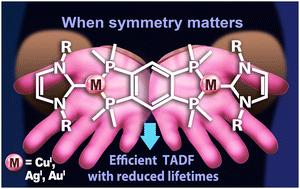当前位置:
X-MOL 学术
›
Inorg. Chem. Front.
›
论文详情
Our official English website, www.x-mol.net, welcomes your
feedback! (Note: you will need to create a separate account there.)
Toward highly efficient TADF-active Cu(I), Ag(I) and Au(I) carbene complexes using symmetry-based design strategy
Inorganic Chemistry Frontiers ( IF 6.1 ) Pub Date : 2024-10-29 , DOI: 10.1039/d4qi01996b Alexander V. Artem'ev, Maxim I. Rogovoy, Ilia M. Odud, Maria P. Davydova, Marianna I. Rakhmanova, Pavel A. Petrov, Valery K. Brel, Oleg I. Artushin, Konstantin A. Brylev, Denis G. Samsonenko, Alexey S. Berezin, Dmitry E. Gorbunov, Nina P. Gritsan
Inorganic Chemistry Frontiers ( IF 6.1 ) Pub Date : 2024-10-29 , DOI: 10.1039/d4qi01996b Alexander V. Artem'ev, Maxim I. Rogovoy, Ilia M. Odud, Maria P. Davydova, Marianna I. Rakhmanova, Pavel A. Petrov, Valery K. Brel, Oleg I. Artushin, Konstantin A. Brylev, Denis G. Samsonenko, Alexey S. Berezin, Dmitry E. Gorbunov, Nina P. Gritsan

|
Coinage metal(I) complexes exhibiting thermally activated delayed fluorescence (TADF) have attracted worldwide attention as emitters for OLEDs. Reducing the emission lifetime and improving the quantum efficiency of such emitters is a current challenge in this hot field. To address this issue (challenge), a symmetry-based design strategy has been applied herein to obtain pseudo-symmetric complexes [M2(tdpb)(NHC)2]2+ (M = Cu, Ag, Au) scaffolded by 1,2,4,5-tetrakis(diphenylphosphino)benzene (tdpb) and N-heterocyclic carbene (NHC) ligands. In the solid state at ambient temperature, the synthesized compounds exhibit cyan to yellow TADF of the metal-to-ligand charge transfer type with excellent quantum yields (58–89%) and short decay times (2.5–15 μs). It is shown that the symmetry-based design strategy leads to a significant increase in the radiative rate constants for the “dimers” [M2(tdpb)(NHC)2]2+ compared to the “monomers” [M(dppb)(NHC)]+ based on 1,2-bis(diphenylphosphino)benzene (dppb). The practical potential of the developed TADF emitters was also demonstrated through their application as innovative thermo- and vapor-chromic emission inks for advanced anti-counterfeiting labels.
中文翻译:

使用基于对称性的设计策略实现高效的 TADF 活性 Cu(I)、Ag(I) 和 Au(I) 卡宾络合物
表现出热激活延迟荧光 (TADF) 的铸币 metal() 配合物作为 OLED 的发射器引起了全世界的关注。缩短此类发射器的发射寿命和提高量子效率是这个热场的当前挑战。为了解决这个问题(挑战),本文应用了一种基于对称性的设计策略,以获得由 1,2,4,5-四(二苯基膦基)苯 (tdpb) 和 N-杂环卡宾 (NHC) 配体支架的伪对称配合物 [M2(tdpb)(NHC)2] 2+(M = Cu、Ag、Au)。在环境温度下的固态下,合成的化合物表现出金属到配体电荷转移类型的青色到黄色 TADF,具有出色的量子产率 (58-89%) 和较短的衰变时间 (2.5-15 μs)。结果表明,与基于 1,2-双(二苯基膦基)苯 (dppb) 的“单体” [M(dppb)(NHC)]+ 相比,基于对称的设计策略导致“二聚体”[M2(tdpb)(NHC)2]2+ 的辐射速率常数显著增加。开发的 TADF 发射器的实用潜力还通过它们作为高级防伪标签的创新热致变色和气相致变色发射油墨的应用得到了证明。
更新日期:2024-10-29
中文翻译:

使用基于对称性的设计策略实现高效的 TADF 活性 Cu(I)、Ag(I) 和 Au(I) 卡宾络合物
表现出热激活延迟荧光 (TADF) 的铸币 metal() 配合物作为 OLED 的发射器引起了全世界的关注。缩短此类发射器的发射寿命和提高量子效率是这个热场的当前挑战。为了解决这个问题(挑战),本文应用了一种基于对称性的设计策略,以获得由 1,2,4,5-四(二苯基膦基)苯 (tdpb) 和 N-杂环卡宾 (NHC) 配体支架的伪对称配合物 [M2(tdpb)(NHC)2] 2+(M = Cu、Ag、Au)。在环境温度下的固态下,合成的化合物表现出金属到配体电荷转移类型的青色到黄色 TADF,具有出色的量子产率 (58-89%) 和较短的衰变时间 (2.5-15 μs)。结果表明,与基于 1,2-双(二苯基膦基)苯 (dppb) 的“单体” [M(dppb)(NHC)]+ 相比,基于对称的设计策略导致“二聚体”[M2(tdpb)(NHC)2]2+ 的辐射速率常数显著增加。开发的 TADF 发射器的实用潜力还通过它们作为高级防伪标签的创新热致变色和气相致变色发射油墨的应用得到了证明。


















































 京公网安备 11010802027423号
京公网安备 11010802027423号